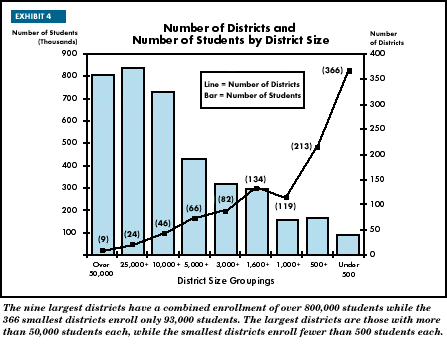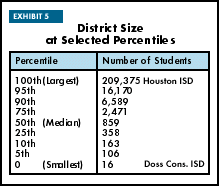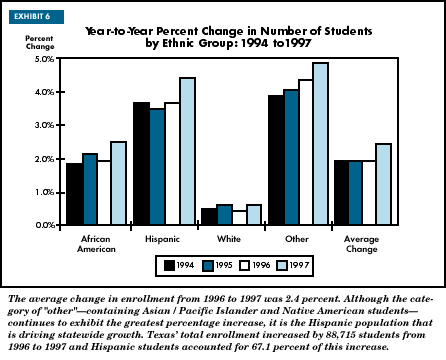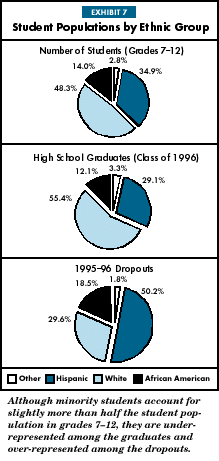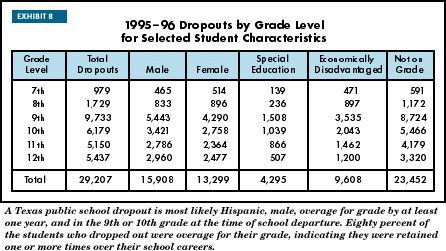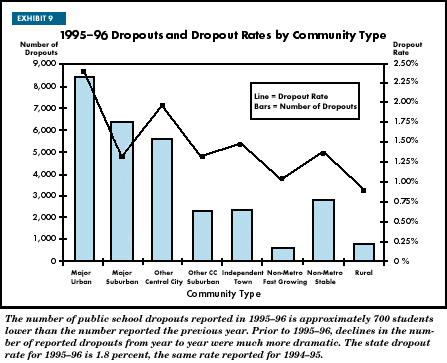
DiversityThe 3.83 million public school students in Texas are served in markedly differing school settings. For example, in 1996-97 only 16 students attended school in the Doss Consolidated Common School District located in the Texas Hill Country, while over 200,000 students received instruction at 286 school sites in the Houston Independent School District, the largest district in the state. The nine largest districts, those with over 50,000 students each, serve 21 percent of all Texas public school students, while the smallest 366 districts (i.e., districts having fewer than 500 students), represent 35 percent of all districts and enroll only 2.4 percent of the state's students. The inverse relationship between the number of districts and the number of enrolled students is a defining characteristic of the Texas public school system. See Exhibit 4 and Exhibit 5 below.
The ethnic distribution of students varies greatly across the state and appears to depend in part on geography, size of the district, and type of community served. Statewide, 54.4 percent of all students are from minority ethnic groups. A minority student is defined as being a member of either the African American, Hispanic, Native American or Asian/Pacific Islander ethnic group. Districts in major urban areas serve an 80.2 percent minority student population while districts in rural areas serve a population that is only 33.1 percent minority. By far the largest minority student group within the state is the Hispanic student population which represents 37.4 percent of all students. The highest percentages of Hispanic students are found in the Edinburg ESC region at the southernmost tip of the state (94.7 percent), and in the El Paso region in far west Texas (83.1 percent). The largest percentage of African American students, 30.6 percent, is in the Beaumont region east of Houston. The eastern, northern and north central parts of the state have the highest percentages of White students, varying between 62.4 and 75.7 percent. The proportion of students from homes experiencing economic hardship also varies across the state. Although the state of Texas does not levy personal income taxes and has little information about family earnings, student eligibility to participate in the national free or reduced-price lunch program is one indicator of student economic status. Districts report that 48.1 percent of Texas public schoolchildren were eligible to participate in this program for the 1996-97 school year. Higher concentrations of economically disadvantaged students are found in major urban districts and in districts with higher percentages of minority students. The lowest percentages of economically disadvantaged students can be found in districts considered to be non-metro "fast growing" and districts suburban to major urban areas. Not surprisingly, districts with lower property wealth generally have higher percentages of economically disadvantaged students. Student participation in special instructional programs differs by community type, district size, and geographic location. For example, a greater percentage of students in rural districts is enrolled in career and technology courses--almost 24.6 percent--compared with 13.5 percent in major urban districts. The highest percentages of students in bilingual or English as a second language (ESL) programs are enrolled in the Edinburg and El Paso service center regions with 37.5 percent and 24.9 percent, respectively. These figures are well above the state average of 11.7 percent. Districts with larger enrollments also report having more students enrolled in bilingual or English as a second language (ESL) programs. Growth in the percentage of students who participate in special education programs has slowed after experiencing a consistent growth rate of approximately 0.4 percent per year over the last four years. In 1996-97, 11.6 percent of all students were identified as receiving special education services, an increase of only 0.1 percent from the previous year. The 1995-96 population of special education students was 11.5 percent of all students. Student Population GrowthIn 1996-97, public schools in Texas served 3,828,975 students in pre-kindergarten through grade 12. Charter schools served 2,412 of these students. The total student count represents a 2.4 percent increase from the prior year, which is a greater rate of increase than the state experienced either of the prior two years. For both 1993-94 and 1994-95, the state's rate of student population growth was 1.9 percent. Of all students enrolled for the 1996-97 school year, nearly 85 percent were served the previous year and the remaining 15 percent were newly enrolled students. This 15 percent includes students entering school for the first time (e.g., pre-kindergarten and kindergarten enrollees) as well as students entering the Texas public education system from other sources, such as private schools or residents new to the state. The percentage of new students has remained stable for at least the past three years. As in prior years, the majority of districts continue to show enrollment increases, but compared to last year, the percentage of districts experiencing growth is larger. For 1996-97, 68.6 percent of districts reported enrollment growth, while 64.8 percent reported increases in 1995-96. Districts located in areas suburban to major urban districts were among those with the greatest growth. The 62 "major suburban" districts averaged a 3.8 percent increase from the prior year. Rural districts as a group increased 0.9 percent from the prior year. Statewide, growth in the minority student population continues to exceed non-minority growth. Minority students now comprise 54.4 percent of the public school population, compared with 53.6 percent in 1995-96. Growth in the minority student population was 3.9 percent, with the greatest increase--4.9 percent--occurring in the Asian/Pacific Islander and Native American populations. However, these two populations, categorized in this document as a single group labeled "other," account for only 2.6 percent of all students. The number of African American students grew by 2.5 percent, representing a net increase of 13,230 students. African Americans comprised 14.3 percent of the total public school population for 1996-97. Although growth in numbers has occurred, the percentage of the African American students within the state student population has remained the same since 1992. The Hispanic rate of growth is 4.3 percent, which exceeded the 1995-96 rate (3.7 percent). Although this rate of growth is not the highest among the ethnic groups, it is the Hispanic population that continues to drive statewide growth. Of the 88,715 student increase in Texas' total enrollment, 67.1 percent or 59,544 were Hispanic. This population now accounts for 37.4 percent of the total number of students. In contrast, the White population grew by only 0.65 percent, or by 11,262 students. This rate of increase is the smallest among all the ethnic groups. See Exhibit 6 below. The percentage of White students statewide has dropped from 49.0 percent five years ago to 45.6 percent this year. Despite the growth for the White student population, the reduction in the percent of White students in the total student population over the last several years is attributable to the increasing relative growth rate of minority students.
Growth by GradeAt the state level all grades reported some growth for the 1996-97 school year. The highest rates of growth occurred in pre-kindergarten, grade 11, and grade 12. Pre-kindergarten grew by 4,933 children, an increase of 4.3 percent over 1995-96. In the upper grades, grade 11 grew 5.7 percent, contributing a gain of 12,227 students. The second highest level of growth occurred in grade 12 at nearly 5.0 percent, an increase of 9,220 students. By far the largest number of students new to the Texas public schools are children entering pre-kindergarten and kindergarten. Over 289,000 students entered public schools at these two grade levels for the 1996-97 school year, which represents nearly 51 percent of all new students. Other than pre-kindergarten and kindergarten, grades 1 and 9 also have a large percentage of new students. Twelve percent of all 1st graders and nearly 11 percent of all 9th graders are students who were not previously enrolled in Texas public schools. These grades are traditional entry points for students previously enrolled in private schools. On average, pre-kindergarten and kindergarten have higher percentages of minority students, 63.9 percent, than the total student population (54.4 percent). Statutory requirements for pre-kindergarten education stipulate that limited English proficient (LEP) or economically disadvantaged pupils are to be identified and served. These characteristics are highly correlated with ethnicity in Texas. In grades 1 through 5, the ethnic distribution remains very similar to the state, while the secondary grades (grades 6-12) have slightly more White students, 48.1 percent compared with 45.6 percent statewide. DropoutsData for students who drop out of Texas public schools are collected in the fall following the year the students left school. Thus, dropout data reported in the 1996-97 edition of Snapshot reflect students who dropped out during the 1995-96 school year. During that year--August 1995 through October 1996--29,207 students in grades 7-12 dropped out of Texas public schools. This is a decline of 711 students from the previous year. The annual dropout rate for 1995-96 is 1.8 percent, the same rate reported in 1994-95. Both the Hispanic and African American student groups continue to be disproportionately represented among dropouts. As shown in Exhibit 7 below, 68.7 percent of all dropouts are either Hispanic or African American. Overall, the percent of total dropouts who are minorities increased slightly from 1994-95. Furthermore, dropout rates for both Hispanic and African American students remain higher than the state average of 1.8 percent. The Hispanic and African American rates were 2.5 percent and 2.3 percent, respectively. The dropout rates for Asian/Pacific Islander, Native American, and White students were 1.1 percent.
Since dropout information has been collected in Texas, Hispanic and African American students have consistently exhibited the greatest dropout rates among all the ethnic groups. However, the gap between the White and nonwhite dropout rates has diminished over time. In 1987-88 the difference between dropout rates for minority and White students was 3.4 percentage points. This difference had closed to 1.3 by 1994-95. Data for the 1995-96 school year show this difference remains at 1.3 percentage points. As demonstrated for the last seven years, 9th grade students represent the greatest number of dropouts, although students in the 12th grade are increasing as a percentage of total dropouts. The 9th grade dropout rate was 2.7 percent, closely followed by a rate of 2.6 percent for 12th graders and 2.3 percent for both 10th and 11th graders. Thirty-three percent of all dropouts are identified as economically disadvantaged, and a staggering 80.3 percent are overage for their grade. Consistent with data reported over the last eight years, more males than females dropped out during 1995-96 (54.5 percent versus 45.5 percent). See Exhibit 8.
Urban districts and districts with high percentages of minority students have the highest dropout rates. Exhibit 9 depicts the relationship between community type and dropout rates. Both minority students and economically disadvantaged students are found in greater numbers in urban areas, which may partially explain these differences in rates.
As a group, districts with the greatest student enrollment--those in urban areas--have consistently reported greater dropout rates than smaller districts. However, the relationship between dropout rates and campus size does not show the same pattern. Among campuses, the dropout rate for the smallest schools (those with fewer than 200 students) is the greatest--a dropout rate of 6.3 percent. Analysis reveals that only 13 percent of these small schools with dropouts are in rural areas. The remainder are small campuses located in urban settings which are specifically designed to serve students at greater risk of dropping out. GraduatesAs with the dropout data, information for graduates of Texas public schools is collected in the fall following the year of graduation. During the 1995-96 school year, 171,844 seniors graduated as the class of 1996 from Texas public schools. This is an increase of 1.6 percent over the class of 1995 graduates. Of the class of 1996 graduates, 15,452 were identified as special education students. Statewide, White students accounted for 55.4 percent of all graduates, Hispanic students 29.1 percent, African American students 12.1 percent, and Asian/Pacific Islander and Native American students the remaining 3.3 percent. Refer to Exhibit 7 above, for a disaggregation of the ethnic groups for the 7th through 12th grade student population, graduates, and dropouts. |
Text & Exhibits | Snapshot '97 | Snapshot | Performance Reporting | TEA Home Page
